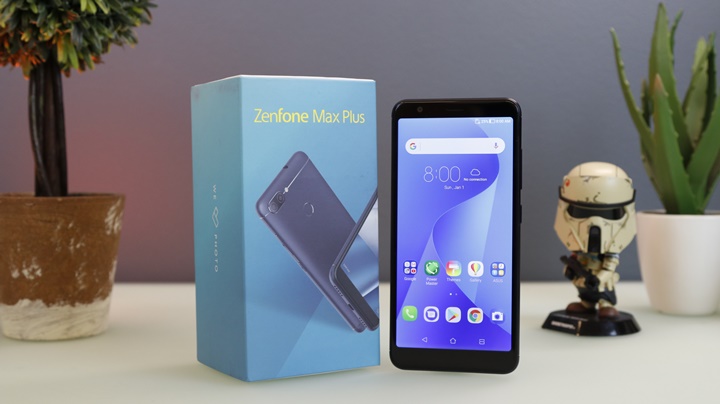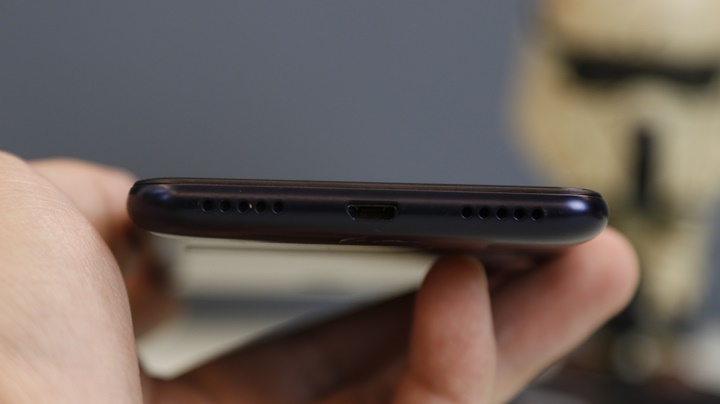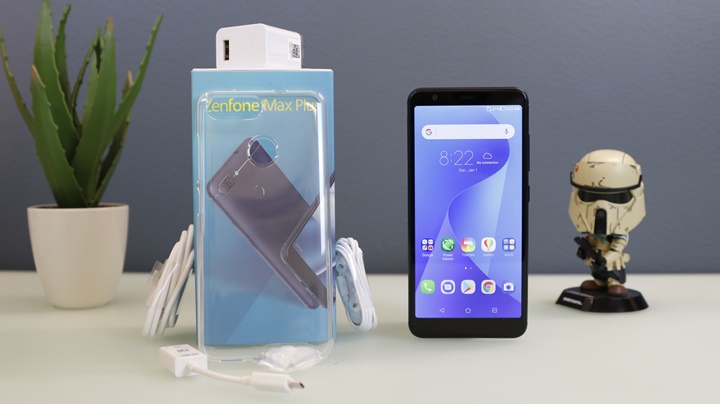It seems like we are getting closer and closer to the official release date of ASUS’ newest smartphone due to the numerous different teasers we’ve been seeing since the start of the year. This newest member of the Zenfone family is the first to sport an 18:9 display and is dubbed as the Zenfone Max Plus. We first caught wind of it back in December, where we were given a brief hands-on time with the device, but this time around we had a little more play time with it.

The Zenfone Max Plus dons a new yet familiar design largely due to its 18:9 display. Although, that different design language can only be seen and felt at the front, as the back of the device shares similar cues from previous Zenfones. It is relatively thicker than most smartphones, although it does maintain a slim aura and feel thanks to the thin side bezels. It is one of, if not, the slimmest device to sport a large capacity battery. The overall design doesn’t bring anything new to the table, but it is simple, clean, and almost elegant.

Up front, we’re greeted with the 5.7-inch FHD+ IPS Display with a resolution of 2160 x 1080, which translates to 424ppi. The display itself has good color reproduction, vibrant colors, and excellent viewing angles. It may not have the highest screen to body ratio at 79.8% but it still provides quite a lot of screen real estate. We’d also have to give props to ASUS for equipping the device with an FHD screen instead of an HD one.

Above the display are the 8MP f/2.0 front shooter, LED notification light, loudspeaker, and light sensor. The bottom is devoid of any buttons as the device uses on-screen navigation, and we do appreciate the presence of a bottom bezel, as it makes for easier landscape operation and gives your thumb a place to grip.

On its right side, we have the volume rockers and the power button, while on the left we have the dual SIM and the dedicated microSD card slot and tray. It was a good call for ASUS to abandon the hybrid setup, as this enables users to use two SIMs without sacrificing storage expansion.

Flipping the phone on its back reveals the dual 16MP 80° FOV standard view + 8MP 120° wide-angle cameras along with the LED flash, and a fingerprint scanner. Found at the bottom is a silver ASUS logo. The antenna bands at the top and bottom also add a little flair to the device.

Up top, are the 3.5mm headphone port and the secondary mic, while at the bottom are the microUSB port, the mono speaker, and the two audio grilles.

The phone has a metallic unibody finish. It has the aura of a premium device due to that 18:9 display and relatively sturdy build. However, the device is quite slippery due to its smooth finish, and the back is a fingerprint magnet.

Thankfully, ASUS included a silicon case in the package to address that pesky problem. Nevertheless, it’s still easy to grip, and is also light and feels good in the hands.
The Zenfone Max Plus is equipped with a 8MP f/2.0 front camera and a dual 16MP + 8MP rear. It has all the features we are familiar with today — Beauty, Pro, Super Resolution, GIF Animation, Panorama, Time Lapse, Portrait and a set of 9 filters for the rear and Auto, Beauty, Selfie Panorama, GIF Animation, Portrait, and a set of 9 filters for the front. It also includes ASUS’ Selfie Master app, which includes Beauty Live, Collage, Slideshow and a shortcut to Video recording. Check out our initial sample shots below.
The device uses ZenUI 4.0 on top of Android 7.0 Nougat. The only pre-installed apps present, apart from a few homebrew apps and the default Google apps, are Facebook, Instagram, and Messenger. This leaves users with 22.65GB of storage out of the initial 32GB.
It has a few distinct features like One hand operation, Multi-window, and Audio Wizard. The UI is actually really clean and has its own app drawer which users can access by swiping upward. Not to mention, it also features reverse charging, making it a phone and a powerbank in one. Other than that, ASUS also equipped the device with facial recognition. Although we encountered a few hiccups with it and it became more of an annoyance than a feature as during setup it would either register your face instantly (even if you’re not yet ready), or it won’t register at all, unless you reposition yourself or restart the setup. When you finally do get to register your face right, recognition fails 80% of the time. In any case, we’ll test this further in our full review.
Under the hood of the Zenfone Max Plus is a MediaTek MT6750T Octa-core processor, Mali T860 GPU, and 4GB of RAM. Initial operation was fast and lag-free, apps installed quickly, and app operations we’re a breeze. We’ll put it through heavier workloads during our full review to completely test its performance. Either way, check out the Zenfone Max Plus’ Antutu benchmark score below.

All in all, the Zenfone Max Plus is shaping up to be quite the contender with its specs and its projected price of under Php 13K. It has a good display with high resolution, punchy colors, and excellent viewing angles. The cameras also perform well. On the flip side, facial recognition could be better and the back is quite the fingerprint magnet. We’ll put it through the paces in the coming days, especially its battery life since it is being touted as the “Battery King”.

Check out our unboxing video below.
ASUS ZenFone Max Plus specs:
5.7-inch FHD+ IPS display @ 2160 x 1080px, 424 ppi
2.5D curved glass
1.5GHz Octa-core 64-bit MediaTek MT6750T
Mali-T860MP2 GPU
4GB RAM
32GB internal storage
expandable via microSD
Dual 16MP f/2.0 + 8MP f/2.4 wide angle AF rear cameras w/ LED flash
8MP front camera w/ screen flash, Face Unlock
4G LTE
Dual SIM Dual standby
WiFi
Bluetooth 4.2
GPS, A-GPS
Gyroscope
Fingerprint scanner
ASUS ZenUI 4.0 (Android 7.0 Nougat)
4,130mAh battery
152.6 x 72.7 x 8.8 mm
160 g
Colors: Black, Silver, Gold

YugaTech.com is the largest and longest-running technology site in the Philippines. Originally established in October 2002, the site was transformed into a full-fledged technology platform in 2005.
How to transfer, withdraw money from PayPal to GCash
Prices of Starlink satellite in the Philippines
Install Google GBox to Huawei smartphones
Pag-IBIG MP2 online application
How to check PhilHealth contributions online
How to find your SIM card serial number
Globe, PLDT, Converge, Sky: Unli fiber internet plans compared
10 biggest games in the Google Play Store
LTO periodic medical exam for 10-year licenses
Netflix codes to unlock hidden TV shows, movies
Apple, Asus, Cherry Mobile, Huawei, LG, Nokia, Oppo, Samsung, Sony, Vivo, Xiaomi, Lenovo, Infinix Mobile, Pocophone, Honor, iPhone, OnePlus, Tecno, Realme, HTC, Gionee, Kata, IQ00, Redmi, Razer, CloudFone, Motorola, Panasonic, TCL, Wiko
Best Android smartphones between PHP 20,000 - 25,000
Smartphones under PHP 10,000 in the Philippines
Smartphones under PHP 12K Philippines
Best smartphones for kids under PHP 7,000
Smartphones under PHP 15,000 in the Philippines
Best Android smartphones between PHP 15,000 - 20,000
Smartphones under PHP 20,000 in the Philippines
Most affordable 5G phones in the Philippines under PHP 20K
5G smartphones in the Philippines under PHP 16K
Smartphone pricelist Philippines 2024
Smartphone pricelist Philippines 2023
Smartphone pricelist Philippines 2022
Smartphone pricelist Philippines 2021
Smartphone pricelist Philippines 2020
The OC says:
If priced right, this looks like a mid-range contender along with the new Nokia 6 … please don’t screw it up with the pricing, ASUS
DarkwingDuckPH says:
What version did you test? And would you know what version will be sold here?
https://www.asus.com/ph/Phone/ZenFone-Max-Plus-M1/Tech-Specs/
sadasdasdsada says:
screw you mediatek for 13k meh